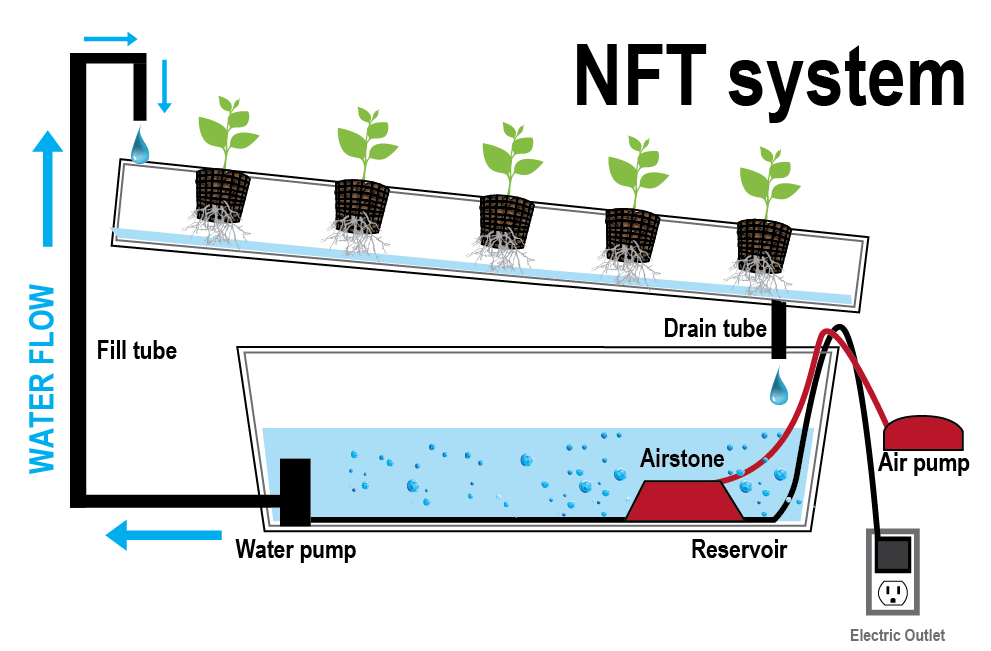
The Different Methods of Hydroponics
There are five popular methods of hydroponics, all of which have their advantages and disadvantages. The method you choose should depend upon which characteristics are most important to you; is it ease of set up, lowest maintenance, largest yields, most reliable or most cost effective? These are just some of the deciding factors.
While all five methods will sound similar, each is slightly different. Each method incorporates growing in a nutrient solution without the use of soil. Each method will also be dependent on water, nutrients and high oxygen content for the roots. We will outline some of the pros and cons of each system to make your decision easier.
Ebb & Flow (aka Flood and Drain)
This is one of the most well known methods of hydroponics and in recent years, has become the most popular method among new hydroponics enthusiasts. This method uses a reservoir to hold your nutrient solution. Above the reservoir will be a tray or growing chamber that will hold nutrient solution during flooding. There will be a pump in the reservoir that will take the solution up to the tray or growing chamber. Here the solution will sit, until the media can absorb the appropriate amount of solution, then it will drain. Some companies make ready to go Ebb & Flow systems, like Botanicare or the Titan Flo-n-Gro. You can also choose to buy the pieces separately, to design a system of your choice.
Pros of Ebb & Flow
You can reuse your nutrient solution.
Requires very few parts to make up the system.
You can use a small pump to run the system.
This method doesn’t usually require a chiller.
It is easy to build.
It is easy to maintain.
The cost of building an Ebb and Flow System is low.
This method works well with organics.
Any type of grow media may be used.
Cons of Ebb & Flow
You may run into a height restriction with the plants because of the height of the reservoir and tray.
Salts and minerals can easily build up in the growing media due to bottom flooding in lieu of top flushing.
Mineral build up can cause a nutrient lockout, which can also cause a nutrient deficiency.
If you start with small plants, the flood height may not be able to reach the short roots in the grow media. You may need to top water or incorporate drip lines until the roots grow longer.
Deep Water Culture (aka DWC)
Deep Water Culture has grown in popularity in recent years. There are companies who have taken the traditional DWC system made it better than ever. One great brand on the market is Current Culture. CC has taken the traditional DWC method and added extra value. Ensuring a long lasting product, by using the best quality components. A DWC system is typically comprised of a main reservoir that hold the bulk of the nutrient solution, and an attached system of buckets through which the nutrient solution circulates. Each attached bucket will be topped with a new pot lid, through which plant roots will grow, and show contain an air stone to ensure proper root oxygenation.
Pros of DWC
Great for water loving, rapid growing plants.
Allows for large root mass.
Flexible plant site sizes.
Fewer plants with larger yield.
Reuses water.
Cost effective to build the DWC system.
Cons of DWC
A chiller will likely be needed.
Plants can be prone to root diseases with DWC system.
May foam up when using organics.
pH fluctuation/ monitoring required.
Root mass may grow so large, it will clog the irrigation lines.
Nutrient Film Technique (aka NFT)
This is a method that has probably been around longer than any other hydroponics methods. You will hear sales people at the grow stores, say it is the “Old School Method.” This method is also popular among commercial growers because of its versatility and aggressiveness. NFT consists of a long grow chamber such as PVC pipe or channel. At evenly spaced intervals along the pipe, there are holes containing either collars, baskets, or in some cases, grow media in which plants are held. The roots of the plant hang down in the hole and a shallow stream, or “film” of water is run across the root tips.
Pros of NFT
The cost of building a NFT system is low.
Constant water movement keeps water from going stagnant.
You can have a lot of plant sites.
You can use any grow media to hold the plant.
You can reuse the water.
Doesn’t have parts to clog.
Great with organics.
No timer to worry about breaking, because the water is always flowing.
Grow media is not required.
Cons of NFT
pH fluctuation/ monitoring required.
If the pump breaks, your plants will die quickly. This is because there is no media to hold water.
May need a chiller.
Plants with short roots will need to be top fed or drip line incorporated, until roots grow to bottom of PVC.
Aeroponics
This is probably the most advanced hydroponics method. A grower will typically by a pre-fabricated Aeroponic system. Botanicare and GH both make ready to go Aeroponic systems, which even a beginner can put together. Once the system is up and running, this system will need to be monitored frequently. This is not a system you will want to leave, while you go on vacation.
Pros of Aeroponics
High oxygen to water ratio.
Can have a lot of plant sites.
Reuses water.
Increased nutrient solution absorption.
Accelerated growth.
Cons of Aeroponics
Highest fluctuations of pH.
Roots need to be watered more often, for short periods of time. This means they can dry out very quickly if not watered enough.
May need a chiller.
Prone to root disease.
If the pump breaks, the plants will die quickly. This is usually because a clay pebble media is used and clogged the pump.
Sprayer clog easy, so isn’t good with organics.
Drip System
Drip systems are used widely in both indoor and outdoor applications. This is something almost any family member, gardener or not, would understand. Drip systems can be designed many different ways, depending on the builder. Usually you have a reservoir that holds your nutrient solution. From the reservoir the solution is run through a main water line from which there are smaller lines leading directly to the base of the plant sites. You can find already manufactured drip systems, but you can also easily build one as well.
Pros of Drip Systems
Can use any type of media.
Cost to build is low.
You can have constant feed of solution or a timed system.
You can choose to reuse the water or run to waste.
You are constantly flushing the solution from the top down, so you don’t have a lot of salt build up.
Since you can use large containers, you can grow long term with a drip system.
Cons of Drip Systems
Can clog easily, so may not be good with organics.
More time consuming at initial set-up.
Since you usually use more media than compared to other hydroponics methods, the absorption rate is slower.
As you can see there are many pros and cons to all hydroponics methods. When choosing a hydroponics method you need to consider all of the pros and cons for each. Do you want a low maintenance, reliable system or do you want a system that can out produce the best, but requires more hands on time and allows less room for error. I would recommend you visit your nearest Hydroponics or Grow Store Retailer to help you choose the right method.





















 © 2017
© 2017
Recent Reviews